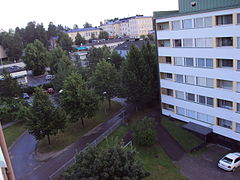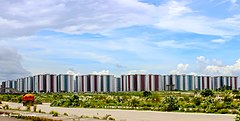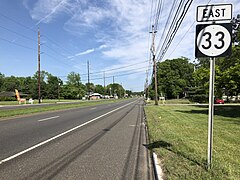
Back Voorstad Afrikaans Underburg ANG ضاحية Arabic Suburbiu AST Şəhərətrafı zona Azerbaijani Биҫтә Bashkir Прадмесце Byelorussian Прадмесьце BE-X-OLD Предградие Bulgarian শহরতলি Bengali/Bangla





A suburb (more broadly suburban area) is an area within a metropolitan area which often contains most of the area's economic activity, which may include commercial and mixed-use.[1][2][3][4][5][6] A suburb can exist either as part of a larger city/urban area or as a separate political entity. The name describes an area that is either more or less densely populated than an inner city.[7] In many metropolitan areas suburbs rise in population during the day and are where most jobs are located; being major commercial and job hubs,[8][9] many suburbs also exist as separate residential communities within commuting distance of a larger city (cf. "commuter town"). Suburbs can have their own political or legal jurisdiction, especially in the United States, but this is not always the case, especially in the United Kingdom, where most suburbs are located within the administrative boundaries of cities.[10] In most English-speaking countries, suburban areas are defined in contrast to central city or inner city areas, but in Australian English and South African English, suburb has become largely synonymous with what is called a "neighborhood" in the U.S., but it is used in contrast with inner city areas.[11]
In the United States, due to historical trends such as white flight, some suburbs have a higher population and higher incomes than their nearby inner cities.[12][13][14][15][16]
In some areas, such as India, China, New Zealand, Canada, the United Kingdom, and parts of the United States, new suburbs are routinely annexed by adjacent cities due to urban sprawl. In others, such as Morocco, France, and much of the United States, many suburbs remain separate municipalities or are governed locally as part of a larger metropolitan area such as a county, district or borough. In the United States, regions beyond the suburbs are known as "exurban areas" or exurbs; exurbs have less population density than suburbs, but still more than rural areas. Suburbs and exurbs are sometimes linked to the nearby city economically, particularly by commuters.
Suburbs first emerged on a large scale in the 19th and 20th centuries as a result of improved rail and road transport, which led to an increase in commuting.[17] In general, they are less densely populated than inner city neighborhoods within the same metropolitan area, and most residents routinely commute to city centers or business districts via private vehicles or public transits; however, there are many exceptions, including industrial suburbs, planned communities, and satellite cities. Suburbs tend to proliferate around cities that have an abundance of adjacent flat land.[18]
- ^ "St Louis City Gross Domestic Product". Fred economic data. Retrieved 7 October 2023.
- ^ "St Louis MO-IL metro area Gross Domestic Product". Fred economic data. Retrieved 7 October 2023.
- ^ "San Fransisco City GDP". Fred economic data. Retrieved 7 October 2023.
- ^ "San Fransisco-Oakland-Hayward MSA Gross Domestic Product". Fred Economic Data. Retrieved 7 October 2023.
- ^ "Cities suburbs and the gray area in between".
- ^ "Types of Zoning".
- ^ "The Demographic Statistical Atlas of the United States - Statistical Atlas".
- ^ "suburbs continue to dominate jobs and job growth".
- ^ "Comprehensive Annual Financial Report".
- ^ Caves, R. W. (2004). Encyclopedia of the City. Routledge. p. 640. ISBN 9780415252256.
- ^ Jain, Shri V. K. (30 April 2021). Applied Ecology and Sustainable Environment. BFC Publications. ISBN 978-93-90880-19-5.
- ^ "A forgotten history of how the US Government Segregated America". NPR. Retrieved 30 November 2023.
- ^ "Demographics for 5 mile radius around Kansas City mo". demographics by radius. Retrieved 28 November 2023.
- ^ "Demographics for a 5 mile radius around Overland Park Kansas". demograpbics by radius. Retrieved 28 November 2023.
- ^ "Demographics for a 5 mile radius around Detroit". demographics by radius. Retrieved 28 November 2023.
- ^ "Demographics for 5 mile radius around Southfield, Michigan". demographics by radius. Retrieved 28 November 2023.
- ^ Hollow, Matthew (2011). "Suburban Ideals on England's Interwar Council Estates". Journal of the Garden History Society. Retrieved 29 December 2012.
- ^ The Fractured Metropolis: Improving the New City, Restoring the Old City, Reshaping the Region[permanent dead link] by Jonathan Barnett, via Google Books.
© MMXXIII Rich X Search. We shall prevail. All rights reserved. Rich X Search

